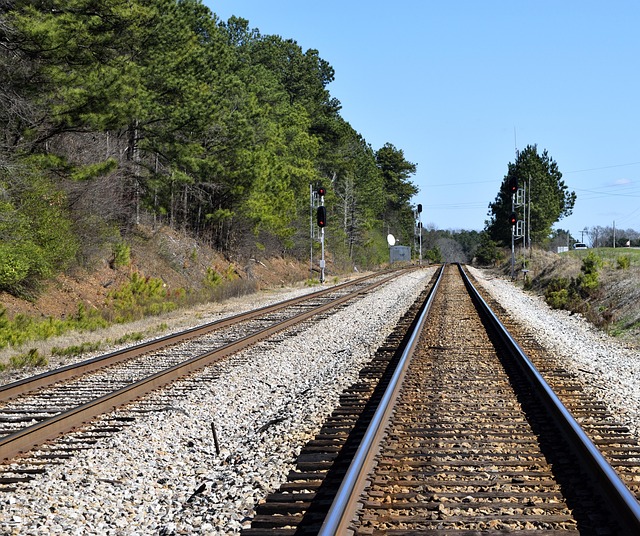In the mid-19th century, as Oregon grew economically thanks to its abundant resources, Lane County embraced railroad expansion. This strategic move linked coastal towns and spurred commerce, transforming rural outposts into thriving urban centers. Key railroads like Southern Pacific and Oregon & California Railway facilitated trade and settlement, leaving a lasting legacy on the county's landscape and economy. Today, historic sites and scenic routes preserve this rich rail heritage for both locals and visitors to explore.
“Unraveling the rich tapestry of Lane County, Oregon’s railroad history is a journey through time and transformation. From its early beginnings to the bustling railway network that once connected communities, this article delves into the profound impact of Oregon’s railroad expansion on Lane County. Explore how key railroads shaped the growth of local towns, influenced economic development, and left an indelible legacy. Discover the rise and fall of the rail industry in the region and learn about ongoing efforts to preserve this vital part of Lane County’s cultural heritage.”
- Early History of Railroads in Lane County, Oregon
- Oregon Railroad Expansion and Its Impact on Lane County
- Key Railroads and Their Roles in Developing Lane County Towns
- The Rise and Fall of the Rail Industry in Lane County
- Preserving Lane County's Railroad Heritage
- The Legacy of Railroads in Shaping Modern Lane County
Early History of Railroads in Lane County, Oregon

The early history of railroads in Lane County, Oregon, is a testament to the transformative power of this innovative mode of transportation. In the mid-19th century, as Oregon experienced a surge in population and economic activity due to its rich natural resources and fertile lands, the need for efficient transportation networks became increasingly apparent. The railroad industry played a pivotal role in connecting remote areas, fostering trade, and facilitating the movement of goods and people.
Lane County, with its strategic location along the Pacific Coast, quickly recognized the potential of railroad expansion. The construction of railroads in this region began in the 1860s, linking various towns and communities that had sprouted up along the way. These rail lines not only facilitated local commerce but also opened up new opportunities for economic growth, attracting businesses and settlers alike. The development of the railroad industry in Lane County became a driving force behind its transformation from a collection of small rural outposts to thriving urban centers, shaping the landscape and economy of the region as we know it today.
Oregon Railroad Expansion and Its Impact on Lane County

Oregon’s railroad expansion played a pivotal role in shaping the landscape and economy of Lane County. As railroads stretched across the state, they connected remote areas, fostering the growth of railroad towns and transforming local economies. Lane County, with its strategic location along the coast, became a vital corridor for transportation and commerce. The arrival of railroads brought about significant changes; it facilitated the movement of goods, people, and ideas, fostering a bustling atmosphere in previously isolated communities.
This period of railroad development led to the establishment of numerous rail-dependent industries in Lane County. The industry attracted businesses and workers, contributing to the county’s diverse and thriving economy. Railroad towns flourished, becoming hubs for social and cultural activities, with vibrant main streets and diverse populations. The historical impact of this era is still visible today, as many original railroad structures and routes remain, offering a glimpse into Lane County’s rich railroad history.
Key Railroads and Their Roles in Developing Lane County Towns

The railroad played a pivotal role in the historical development of Lane County, Oregon. Key railroads, such as the Southern Pacific and the Oregon & California Railway (O&C), were instrumental in connecting the region to the rest of the country during the late 19th and early 20th centuries. These railways facilitated the transportation of goods, people, and ideas, fostering economic growth and contributing to the establishment of vibrant railroad towns throughout the county.
Each railroad had a distinct impact on local communities. The Southern Pacific, for instance, connected major cities like Eugene and Corvallis, enabling the exchange of agricultural products and manufactured goods. Meanwhile, the O&C Railway, with its challenging yet successful construction through rugged terrain, opened up remote areas for settlement and resource extraction. These railroads not only shaped the physical landscape but also left an indelible mark on the social and cultural fabric of Lane County towns, leaving a legacy that continues to resonate in the region’s rich history.
The Rise and Fall of the Rail Industry in Lane County

The rise and fall of the rail industry in Lane County, Oregon, is a captivating chapter in the region’s history. In the late 19th century, Oregon was undergoing rapid growth, driven in part by the ambitious Oregon Railroad Expansion Project. This period saw the construction of numerous railroads across the state, including significant lines through Lane County. The county’s strategic location along the coast and its connection to major interior regions made it an ideal hub for railroad development. Several rail towns sprang up, becoming thriving centers of commerce and industry, with tracks that stretched far into the countryside, facilitating transportation and trade.
However, as time progressed, the once-thriving Lane County rail industry began to decline. The rise of road transport and subsequent highway system in the 20th century led to a shift in focus away from railroads. Many lines were abandoned, and the train stations that once bustled with activity stood empty. Despite these challenges, remnants of the railroad’s legacy remain evident today, preserved by local historical societies and enthusiasts who keep the memories of these bygone days alive.
Preserving Lane County's Railroad Heritage

Lane County’s rich railroad heritage is a vital part of its historical narrative, showcasing the county’s role in Oregon’s broader rail development. The expansion of railroads across Oregon in the 19th century brought significant changes to Lane County, transforming it into a bustling hub of transportation and commerce. Today, many remnants of this era still stand, offering a glimpse into the past.
Preserving these historic railroad towns and infrastructure is crucial for understanding Lane County’s past and showcasing its contribution to Oregon’s railroad industry. Many local efforts focus on restoring old railway stations, documenting the history of prominent railroads like the Southern Pacific and Oregon & California Railway, and maintaining the scenic routes that once connected cities across the state. These initiatives ensure that the legacy of Lane County’s rail industry remains vibrant, allowing both locals and visitors to appreciate and learn from its historical significance.
The Legacy of Railroads in Shaping Modern Lane County

The legacy of railroads in shaping modern Lane County, Oregon, is a fascinating chapter in the region’s history. The late 19th and early 20th centuries witnessed an intense period of railroad expansion across the state, including significant developments in Lane County. The construction of railways transformed the landscape, connecting remote areas and fostering economic growth. These transportation networks became lifelines for rural communities, facilitating trade and commerce while attracting new residents who sought opportunities along the tracks.
Railroads played a pivotal role in establishing Lane County as a prominent agricultural hub. They enabled the efficient transport of local produce to markets beyond the county lines, promoting the prosperity of nearby towns and farms. The industry’s boom led to the establishment of several railroad towns, each with its unique identity and contribution to the region’s cultural tapestry. Today, remnants of these historic railroads can still be seen along scenic routes, serving as reminders of Lane County’s rich rail heritage and its enduring impact on shaping the modern landscape and community.
